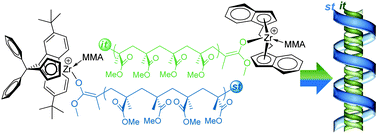This contribution reports the first in situ stereocomplexing polymerization of methyl methacrylate (MMA) using a pair of diastereospecific coordination polymerization catalysts for rapid, high-yield, ambient-temperature production of crystalline stereocomplex poly(methyl methacrylate), sc-PMMA, with high Tm up to 217 °C. The diastereospecific catalyst pair is conveniently generated by in situ activation of a mixture of C2- and Cs-ligated metallocene bis(ester enolate)s with [Ph3C][B(C6F5)4], which is highly active, stereospecific, and controlled for coordination–addition polymerization of MMA to afford crystalline sc-PMMA in typically high to quantitative yields within only minutes of reaction. The isotactic/syndiotactic (it/st) composition of the sc-PMMA materials can be modulated by simply adjusting the relative ratio of the diastereospecific catalysts derived from pre-catalysts such as C2-ligated rac-(EBI)ZrMe[OC(OiPr)![[double bond, length as m-dash]](https://www.rsc.org/images/entities/char_e001.gif) CMe2] and Cs-ligated [Ph2C(Cp)(2,7-tBu2-Flu)]Zr[OC(OiPr)
CMe2] and Cs-ligated [Ph2C(Cp)(2,7-tBu2-Flu)]Zr[OC(OiPr)![[double bond, length as m-dash]](https://www.rsc.org/images/entities/char_e001.gif) CMe2]2; such catalysts have also been used separately to produce highly stereoregular it- and st-PMMAs and their corresponding sc-PMMA transparent film that exhibits nearly idealized characteristics: Mn = 44.2 kDa (vs. the calculated 40.1 kDa), PDI = 1.14, Tg = 96 °C, Tm = 213 °C, mm = 29.2%, rr = 62.3% (it/st ≈ 1/2), and visible transmittance = 92–95%. The in situ PMMA stereocomplexation can also occur in an it/st ratio deviating from the commonly recognized ratio of 1/2. Analysis of two such sc-PMMA materials with it/st ≈ 1/1 and ≈ 1/3 by wide-angle X-ray scattering (WAXS) has revealed essentially the same WAXS profile with nearly identical crystalline diffraction peaks attributed to sc-PMMA. The dynamic light scattering (DLS) results of the in situ stereocomplexing polymerization by a diastereospecific catalyst pair, obtained by monitoring the reaction in real time with DLS, indicate that stereocomplexation occurs as the diastereomeric PMMA chains are continuously growing. The presence of nanocages such as POSS and C60, which can be encapsulated by st-PMMA, in the stereocomplexing MMA polymerization system can completely disrupt or have no effect on the stereocomplexation, or enable both stereocomplexation and inclusion complexation processes to occur, depending on the type of nanocage employed.
CMe2]2; such catalysts have also been used separately to produce highly stereoregular it- and st-PMMAs and their corresponding sc-PMMA transparent film that exhibits nearly idealized characteristics: Mn = 44.2 kDa (vs. the calculated 40.1 kDa), PDI = 1.14, Tg = 96 °C, Tm = 213 °C, mm = 29.2%, rr = 62.3% (it/st ≈ 1/2), and visible transmittance = 92–95%. The in situ PMMA stereocomplexation can also occur in an it/st ratio deviating from the commonly recognized ratio of 1/2. Analysis of two such sc-PMMA materials with it/st ≈ 1/1 and ≈ 1/3 by wide-angle X-ray scattering (WAXS) has revealed essentially the same WAXS profile with nearly identical crystalline diffraction peaks attributed to sc-PMMA. The dynamic light scattering (DLS) results of the in situ stereocomplexing polymerization by a diastereospecific catalyst pair, obtained by monitoring the reaction in real time with DLS, indicate that stereocomplexation occurs as the diastereomeric PMMA chains are continuously growing. The presence of nanocages such as POSS and C60, which can be encapsulated by st-PMMA, in the stereocomplexing MMA polymerization system can completely disrupt or have no effect on the stereocomplexation, or enable both stereocomplexation and inclusion complexation processes to occur, depending on the type of nanocage employed.
![[double bond, length as m-dash]](https://www.rsc.org/images/entities/char_e001.gif) CMe2] and Cs-ligated [Ph2C(Cp)(2,7-tBu2-Flu)]Zr[OC(OiPr)
CMe2] and Cs-ligated [Ph2C(Cp)(2,7-tBu2-Flu)]Zr[OC(OiPr)![[double bond, length as m-dash]](https://www.rsc.org/images/entities/char_e001.gif) CMe2]2; such
CMe2]2; such 

 Please wait while we load your content...
Please wait while we load your content...